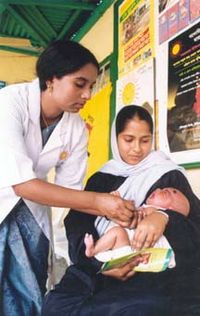
Photo from wikipedia
Background The syphilis diagnostic algorithms applied in different countries vary significantly depending on the local syphilis epidemiology and other considerations, including the expected workload, the need for automation in the… Click to show full abstract
Background The syphilis diagnostic algorithms applied in different countries vary significantly depending on the local syphilis epidemiology and other considerations, including the expected workload, the need for automation in the laboratory and budget factors. This study was performed to investigate the efficacy of traditional and reverse syphilis diagnostic algorithms during general health checkups. Methods In total, 1,000 blood specimens were obtained from 908 men and 92 women during their regular health checkups. Traditional screening and reverse screening were applied to the same specimens using automatic rapid plasma regain (RPR) and Treponema pallidum latex agglutination (TPLA) tests, respectively. Specimens that were reverse algorithm (TPLA) reactive, were subjected to a second treponemal test performed by using the chemiluminescent microparticle immunoassay (CMIA). Results Of the 1,000 specimens tested, 68 (6.8%) were reactive by reverse screening (TPLA) compared with 11 (1.1%) by traditional screening (RPR). The traditional algorithm failed to detect 48 specimens [TPLA(+)/RPR(−)/CMIA(+)]. The median TPLA cutoff index (COI) was higher in CMIA-reactive cases than in CMIA-nonreactive cases (90.5 vs 12.5 U). Conclusions The reverse screening algorithm could detect the subjects with possible latent syphilis who were not detected by the traditional algorithm. Those individuals could be provided with opportunities for evaluating syphilis during their health checkups. The COI values of the initial TPLA test may be helpful in excluding false-positive TPLA test results in the reverse algorithm.
Journal Title: Annals of Laboratory Medicine
Year Published: 2017
Link to full text (if available)
Share on Social Media: Sign Up to like & get
recommendations!